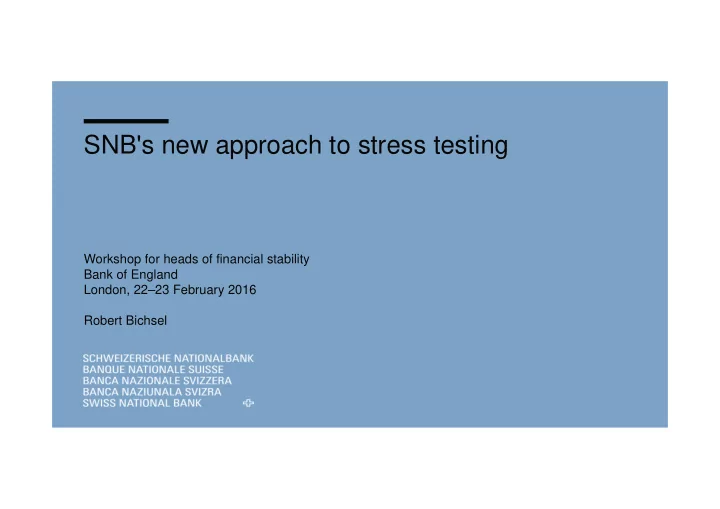

SNB's new approach to stress testing Workshop for heads of financial stability Bank of England London, 22–23 February 2016 Robert Bichsel
Classic approach: top down macro stress testing − Stress Testing developed in early 2000's was top down macro approach: 1. Estimating sensitivity parameters of banks’ earnings/write-downs/losses to macro shocks (individual banks and system as a whole) 2. Predicting the impact of macro-shocks on banks by using these estimated parameters − Major drawbacks: − Data quality and identification issues − Poor fit / out of sample performance in particular at individual bank level − Too simplistic to adequately capture complexity and of banks’ businesses and loss-drivers (e.g.: net interest income) − Structural breaks cannot be depicted 2 24/03/2016
New approach: ‘building-blocks’ (BB) − Objective : development of a comprehensive, reliable and versatile tool for assessing the resilience of individual banks and the banking system − Approach : breaking down entire business/risk exposure in Building Blocks (BB): − 1 business/risk type = 1 block − Modelling approaches differ across blocks to reflect risk type and complexity ( see focus on IRRBB ) − Impact of scenario: aggregation of the results from individual blocks − Differentiated approach across banks (G-SIBs vs DoBs) and businesses reflecting priorities and resource allocation − Perspective : assessment of financial stability (>< prudential measures) State of Development : Instrument already in use but ongoing developments/refinements 3 24/03/2016
Key elements of scenario analysis using BB approach 1. Definition of scenario 2. Translation of a macro stress scenario into shocks to primary risk parameters (mix of empirics and ‘expert judgment’) 3. Loss: function of exposures and primary risk parameter for each block 4. Aggregation of results from individual BB Central assumptions: B/S volume is held constant and static (G-SIBs and most BBs for DOBs) No management actions No interaction between BBs 4 24/03/2016
Differentiation of BB approach across banks: G-SIBs vs DOBs Sample : − G-SIBs: 2 universal banks (UBS and Credit Suisse) representing 1/4 of domestic credit market − DoBs: About 100 "classical" commercial banks representing 2/3 of domestic credit market Building blocks : − G-SIBs: 12 risk modules covering market, credit, operational, funding and business risks − DOBs: 6 risk modules focusing on main risks (credit risks and IRRBB) Data : − G-SIBs: Specific granular reporting templates for each BB filled out by banks quarterly (exposures + results from sensitivity analysis) − DOBs: Use of existing supervisory exposure data -> enables comparability/standardization and plausibility-check of banks’ inputs 5 24/03/2016
Focus on Interest Rate Risk in the Banking Book (IRRBB) − Objective : reliable simulation of interest rate shock impact on banks’ net interest income (70% of DOBs' income) − Focus: individual banks and banking system − Modeling approach : − Separate modeling of assets and liabilities to consider maturity transformation − Granular approach to differentiate margins / rates across products and consider shifts across products at renewal − Data : − Cash-flows of B/S positions and linear derivatives according to repricing maturities from standard (>< specific) regulatory reporting (IRR – NPV data approach) − Enhancement to granularity by using granular balance sheet data − Validation : Interactions with individual banks to validate the approach (plausibility checks) 6 24/03/2016
Focus on Interest Rate Risk in the Banking Book (ctd.) Versatile but also challenging : − Can simulate the direct impact on net interest income of virtually any interest rate scenario − Coupled with BB1 and BB2 (credit risk) – covers both the direct and indirect interest rate risk (ex: correction housing market) − Allows/requires explicit and flexible modelling of elements such as: − Banks’ margin on new loans − Margin compression due to implicit floor at zero on deposits in negative rate environment − Hedging strategies − Clients' behavior (hot money?) in the event of monetary tightening (especially now) − Specifics regarding implementation of monetary policy (especially now) 7 24/03/2016
Focus on Interest Rate Risk in the Banking Book (ctd.) 8 24/03/2016
Conclusion − "Building Blocks" stress testing approach proves extremely useful − Is the main risk/resilience monitoring tool at SNB − Is here to stay >< top-down macro- stress tests − Offers flexibility − Differentiated approach for different risk and bank categories − Can simulate the impact of a wide range of scenarios − Disciplining effect: forces us to explicitly deal with assumptions 9 24/03/2016
Conclusion (ctd.) However: − Development and maintenance costs are high − Not a prediction methodology, but a what-if analysis tool − Limited coverage (e.g. banks vs non-banks) − Drawbacks of flexibility – coping with a large number of explicit assumptions − Risk of becoming a 'sausage machine' Hunger for more? Contact Roland.Goetschman@snb.ch (Project Leader) 10 24/03/2016
Appendix - BB for G-SIBs: Data 12 24/03/2016
Recommend
More recommend